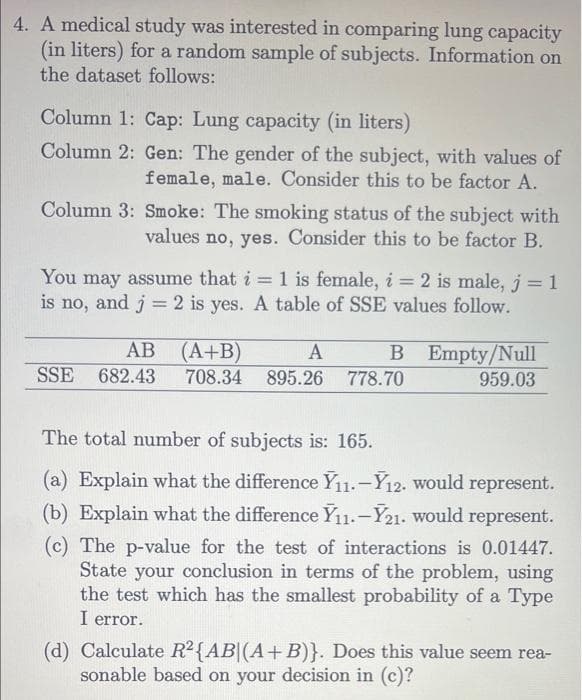4. A medical study was interested in comparing lung capacity (in liters) for a random sample of subjects. Information on the dataset follows: Column 1: Cap: Lung capacity (in liters) Column 2: Gen: The gender of the subject, with values of female, male. Consider this to be factor A. Column 3: Smoke: The smoking status of the subject with values no, yes. Consider this to be factor B. = You may assume that i 1 is female, i = 2 is male, j = 1 is no, and j = 2 is yes. A table of SSE values follow. AB (A+B) A B Empty/Null 959.03 SSE 682.43 708.34 895.26 778.70 The total number of subjects is: 165. (a) Explain what the difference Y11.-Y12. would represent. (b) Explain what the difference Y₁1.-Y21. would represent. (c) The p-value for the test of interactions is 0.01447. State your conclusion in terms of the problem, using the test which has the smallest probability of a Type I error. (d) Calculate R² {AB|(A+B)}. Does this value seem rea- sonable based on your decision in (c)?
4. A medical study was interested in comparing lung capacity (in liters) for a random sample of subjects. Information on the dataset follows: Column 1: Cap: Lung capacity (in liters) Column 2: Gen: The gender of the subject, with values of female, male. Consider this to be factor A. Column 3: Smoke: The smoking status of the subject with values no, yes. Consider this to be factor B. = You may assume that i 1 is female, i = 2 is male, j = 1 is no, and j = 2 is yes. A table of SSE values follow. AB (A+B) A B Empty/Null 959.03 SSE 682.43 708.34 895.26 778.70 The total number of subjects is: 165. (a) Explain what the difference Y11.-Y12. would represent. (b) Explain what the difference Y₁1.-Y21. would represent. (c) The p-value for the test of interactions is 0.01447. State your conclusion in terms of the problem, using the test which has the smallest probability of a Type I error. (d) Calculate R² {AB|(A+B)}. Does this value seem rea- sonable based on your decision in (c)?
Algebra & Trigonometry with Analytic Geometry
13th Edition
ISBN:9781133382119
Author:Swokowski
Publisher:Swokowski
Chapter4: Polynomial And Rational Functions
Section4.3: Zeros Of Polynomials
Problem 65E
Related questions
Question

Transcribed Image Text:4. A medical study was interested in comparing lung capacity
(in liters) for a random sample of subjects. Information on
the dataset follows:
Column 1: Cap: Lung capacity (in liters)
Column 2: Gen: The gender of the subject, with values of
female, male. Consider this to be factor A.
Column 3: Smoke: The smoking status of the subject with
values no, yes. Consider this to be factor B.
=
You may assume that i 1 is female, i = 2 is male, j = 1
is no, and j = 2 is yes. A table of SSE values follow.
AB
(A+B)
A
B
Empty/Null
959.03
SSE 682.43 708.34 895.26
778.70
The total number of subjects is: 165.
(a) Explain what the difference Y11.-Y12. would represent.
(b) Explain what the difference Y₁1.-Y21. would represent.
(c) The p-value for the test of interactions is 0.01447.
State your conclusion in terms of the problem, using
the test which has the smallest probability of a Type
I error.
(d) Calculate R² {AB (A+B)}. Does this value seem rea-
sonable based on your decision in (c)?
Expert Solution
This question has been solved!
Explore an expertly crafted, step-by-step solution for a thorough understanding of key concepts.
This is a popular solution!
Trending now
This is a popular solution!
Step by step
Solved in 2 steps

Recommended textbooks for you

Algebra & Trigonometry with Analytic Geometry
Algebra
ISBN:
9781133382119
Author:
Swokowski
Publisher:
Cengage

Linear Algebra: A Modern Introduction
Algebra
ISBN:
9781285463247
Author:
David Poole
Publisher:
Cengage Learning

Algebra & Trigonometry with Analytic Geometry
Algebra
ISBN:
9781133382119
Author:
Swokowski
Publisher:
Cengage

Linear Algebra: A Modern Introduction
Algebra
ISBN:
9781285463247
Author:
David Poole
Publisher:
Cengage Learning